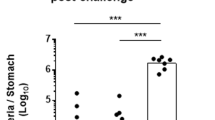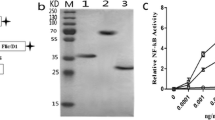Abstract
The aim of this study was to delineate the role of the Fas pathway in vaccination against Helicobacter pylori. C57BL/6 and Fas ligand–deficient (gld) mice were divided into 3 groups: control, H. pyloriinfected, and orally vaccinated (H. pyloriwhole cell sonicate and cholera toxin adjuvant). Oral vaccination prevented H. pyloricolonization in 78% of C57BL/6 mice compared to only 18% of gldmice. Vaccination did not alter the degree of apoptosis in either strain of mice. Vaccination led to significant increase in interleukin (IL)-5 and IL-10 in C57BL/6 but not gldmice. H. pyloriinfection increased interferon (IFN)-γ levels in C57BL/6 but not in gldmice while vaccination had no effect on IFN-γ levels in either strain. Oral vaccination is not effective in Fas ligand–deficient mice likely owing to lack of effective cytokine responses. This indicates that the Fas pathway plays a critical role in promoting an appropriate effector response following H. pylorivaccination.
Similar content being viewed by others
References
Suerbaum S, Michetti P: Helicobacter pylori infection. N Engl J Med 347:1175–1186, 2002
Shirin H, Moss SF: Helicobacter pylori induced apoptosis. Gut 43:592–594, 1998
Goh KL: Update on the management of Helicobacter pylori infection, including drug-resistant organisms. J Gastroenterol Hepatol 17:482–487, 2002
Lembo A, Caradonna L, Magrone T, et al.: Helicobacter pylori infection, immune response and vaccination. Curr Drug Targets Immune Endocr Metabol Disord 1:199–208, 2001
Kusters JG: Recent developments in Helicobacter pylori vaccination. Scand J Gastroenterol Suppl:15–21, 2001
Ruggiero P, Peppoloni S, Rappuoli R, Del Giudice G: The quest for a vaccine against Helicobacter pylori: How to move from mouse to man? Microbes Infect 5:749–756, 2003
Saldinger PF, Porta N, Launois P, et al.: Immunization of BALB/c mice with Helicobacter urease B induces a T helper 2 response absent in Helicobacter infection. Gastroenterology 115:891–897, 1998
Hatzifoti C, Wren BW, Morrow WJ: Helicobacter pylori vaccine strategies#x2013;-triggering a gut reaction. Immunol Today 21:615–619, 2000
Garhart CA, Nedrud JG, Heinzel FP, Sigmund NE, Czinn SJ: Vaccine-induced protection against Helicobacter pylori in mice lacking both antibodies and interleukin-4. Infect Immun 71:3628–633, 2003
Akhiani AA, Pappo J, Kabok Z, et al.: Protection against Helicobacter pylori infection following immunization is IL-12-dependent and mediated by Th1 cells. J Immunol 169:6977–6984, 2002
Akhiani AA, Schon K, Lycke N: Vaccine-induced immunity against Helicobacter pylori infection is impaired in IL-18-deficient mice. J Immunol 173:3348x2013;3356, 2004
Ashkenazi A, Dixit VM: Death receptors: Signaling and modulation. Science 281:1305–, 1998
Wajant H: The Fas signaling pathway: More than a paradigm. Science 296:1635–1636, 2002
Nagata S, Suda T: Fas and Fas ligand: lpr and gld mutations. Immunol Today 16:39–43, 1995
Matiba B, Mariani SM, Krammer PH: The CD95 system and the death of a lymphocyte. Semin Immunol 9:59–13;68, 1997
Takahashi T, Tanaka M, Brannan CI, et al.: Generalized lymphoproliferative disease in mice, caused by a point mutation in the Fas ligand. Cell 76:969–976, 1994
Houghton JM, Bloch LM, Goldstein M, Von Hagen S, Korah RM: In vivo disruption of the fas pathway abrogates gastric growth alterations secondary to Helicobacter infection. J Infect Dis 182:856–864, 2000
Jones NL, Day AS, Jennings H, Shannon PT, Galindo-Mata E, Sherman PM: Enhanced disease severity in Helicobacter pylori-infected mice deficient in Fas signaling. Infect Immun 70:2591–2597, 2002
Lee A, O'Rourke J, De Ungria MC, Robertson B, Daskalopoulos G, Dixon MF: A standardized mouse model of Helicobacter pylori infection: Introducing the Sydney strain. Gastroenterology 112:1386–1397, 1997
Jones NL, Day AS, Jennings HA, Sherman PM: Helicobacter pylori induces gastric epithelial cell apoptosis in association with increased Fas receptor expression. Infect Immun 67:4237–4242, 1999
Jones NL, Shannon PT, Cutz E, Yeger H, Sherman PM: Increase in proliferation and apoptosis of gastric epithelial cells early in the natural history of Helicobacter pylori infection. Am J Pathol 151:1695–1703, 1997
Sutton P, Danon SJ, Walker M, et al.: Post-immunisation gastritis and Helicobacter infection in the mouse: A long term study. Gut 49:467–473, 2001
Wang J, Brooks EG, Bamford KB, Denning TL, Pappo J, Ernst PB: Negative selection of T cells by Helicobacter pylori as a model for bacterial strain selection by immune evasion. J Immunol 167:926–934, 2001
Eaton KA, Krakowka S: Chronic active gastritis due to Helicobacter pylori in immunized gnotobiotic piglets. Gastroenterology 103:1580–1586, 1992
Raghavan S, Svennerholm AM, Holmgren J: Effects of oral vaccination and immunomodulation by cholera toxin on experimental Helicobacter pylori infection, reinfection, and gastritis. Infect Immun 70:4621–2002
Garhart CA, Redline RW, Nedrud JG, Czinn SJ: Clearance of Helicobacter pylori Infection and resolution of postimmunization gastritis in a kinetic study of prophylactically immunized mice. Infect Immun 70:3529–3538, 2002
Menaker RJ, Jones NL: Fascination with bacteria-triggered cell death: The significance of Fas-mediated apoptosis during bacterial infection in vivo. Microbes Infect 5:1149–1158, 2003
Kohda K, Tanaka K, Aiba Y, Yasuda M, Miwa T, Koga Y: Role of apoptosis induced by Helicobacter pylori infection in the development of duodenal ulcer. Gut 44:456–462, 1999
Scotiniotis IA, Rokkas T, Furth EE, Rigas B, Shiff SJ: Altered gastric epithelial cell kinetics in Helicobacter pylori-associated intestinal metaplasia: Implications for gastric carcinogenesis. Int J Cancer 85:192–200, 2000
Mohammadi M, Nedrud J, Redline R, Lycke N, Czinn SJ: Murine CD4 T-cell response to Helicobacter infection: TH1 cells enhance gastritis and TH2 cells reduce bacterial load. Gastroenterology 113:1848–1857, 1997
Cohen PL, Eisenberg RA: Lpr and gld: Single gene models of systemic autoimmunity and lymphoproliferative disease. Annu Rev Immunol 9:243–269, 1991
Giese T, Davidson WF: Chronic treatment of C3H-lpr/lpr and C3H-gld/gld mice with anti-CD8 monoclonal antibody prevents the accumulation of double negative T cells but not autoantibody production. J Immunol 152:2000–2010, 1994
Giese T, Davidson WF: The accumulation of B220+ CD4Ȓ CD8Ȓ (DN) T cells in C3H-lpr/lpr mice is not accelerated by the stimulation of CD8+ T cells or B220+ DN T cells with staphylococcal enterotoxin B and occurs independently of V beta 8+ T cells. Int Immunol 7:1213–1223, 1995
Giese T, Davidson WF: In CD8+ T cell-deficient lpr/lpr mice, CD4+ B220+ and CD4+ B220-T cells replace B220+ double-negative T cells as the predominant populations in enlarged lymph nodes. J Immunol 154:4986–4995, 1995
Ford MS, Young KJ, Zhang Z, Ohashi PS, Zhang L: The immune regulatory function of lymphoproliferative double negative T cells in vitro and in vivo. J Exp Med 196:261–67, 2002
Hamad AR, Mohamood AS, Trujillo CJ, Huang CT, Yuan E, Schneck JP: B220+ double-negative T cells suppress polyclonal T cell activation by a Fas-independent mechanism that involves inhibition of IL-2 production. J Immunol 171:2421–2426, 2003
Author information
Authors and Affiliations
Corresponding author
Rights and permissions
About this article
Cite this article
Avitzur, Y., Galindo-Mata, E. & Jones, N.L. Oral Vaccination Against Helicobacter pyloriInfection Is Not Effective in Mice With Fas Ligand Deficiency. Dig Dis Sci 50, 2300–2306 (2005). https://doi.org/10.1007/s10620-005-3051-5
Received:
Accepted:
Issue Date:
DOI: https://doi.org/10.1007/s10620-005-3051-5




